INSTITUT SUPERIEUR D'ANTHROPOLOGIE
INSTITUTE OF ANTHROPOLOGY
ONLINE COURSES / COURS A DISTANCE
FALL TERM : OCTOBER 2015
REGISTER NOW
MONGOLIE – 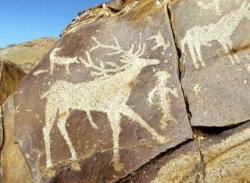 - The governor of Arkhangai aimag signed August 11 a Cooperation Agreement with the History and Archaeology Department of the Academy of Sciences on the Mongolia-Monaco joint “Northern Tamir and Hun Empire” expedition. Head of the archaeology expedition Jerome Magat gave presentation to the governor on the planned works to study the stone-age settlements, mounds from bronze and early iron ages and Hunnu tombs, located in northern Tamir river, valley of Bayantsagaan, and rocks of Avdarkhad. The 60-day expedition aims at discovering new research instruments to make deeper studies on the Hun empire periods, as well as the bronze and early iron ages. The action is co-hosted by the Museum of Prehistoric Anthropology in Monaco.
- The governor of Arkhangai aimag signed August 11 a Cooperation Agreement with the History and Archaeology Department of the Academy of Sciences on the Mongolia-Monaco joint “Northern Tamir and Hun Empire” expedition. Head of the archaeology expedition Jerome Magat gave presentation to the governor on the planned works to study the stone-age settlements, mounds from bronze and early iron ages and Hunnu tombs, located in northern Tamir river, valley of Bayantsagaan, and rocks of Avdarkhad. The 60-day expedition aims at discovering new research instruments to make deeper studies on the Hun empire periods, as well as the bronze and early iron ages. The action is co-hosted by the Museum of Prehistoric Anthropology in Monaco.
http://en.montsame.mn/index.php?option=com_k2&view=item&id=12218%3Amongolia-monaco-archaeology-expedition-in-search-of-new-anthropological-findings&Itemid=696
ISRAEL – 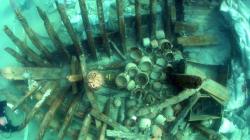 Dor Beach - Now that it's finally been examined, a shipwreck found decades years ago off the Israeli coast turns out to be a long-lost ship that Baron Edmond James de Rothschild used to bring supplies from France to the Holy Land, suggest archaeologists from Haifa University. Lost from the record, the ship apparently sank very near its destination, the Israeli coast more than 100 years ago. That would explain what happened to the mysteriously missing third ship the baron used to carry raw materials from France to a glass factory he had built at the coastal village of Tantura. The cargo also included roof tiles and other materials for the nearby, newly established Jewish town of Zichron Yaakov. The baron was known to have sold two of his three ships, but the fate of the third had remained unknown. Now the wreck found off Dor Beach in1976 has been tentatively identified as that ship.
Dor Beach - Now that it's finally been examined, a shipwreck found decades years ago off the Israeli coast turns out to be a long-lost ship that Baron Edmond James de Rothschild used to bring supplies from France to the Holy Land, suggest archaeologists from Haifa University. Lost from the record, the ship apparently sank very near its destination, the Israeli coast more than 100 years ago. That would explain what happened to the mysteriously missing third ship the baron used to carry raw materials from France to a glass factory he had built at the coastal village of Tantura. The cargo also included roof tiles and other materials for the nearby, newly established Jewish town of Zichron Yaakov. The baron was known to have sold two of his three ships, but the fate of the third had remained unknown. Now the wreck found off Dor Beach in1976 has been tentatively identified as that ship.
http://www.haaretz.com/life/archaeology/1.670603
ZIMBABWE–  Mapela - In southern Zimbabwe lies Mapela, the remains of what was once a thriving community, believed to have existed for more than 800 years. First investigated in the 1960s, it was subsequently abandoned until a new excavation project commenced two years ago. Carbon dating of recovered objects suggests they belonged to people who lived on the inaccessible site between the eighth and the 18th centuries. ‘The people living at Mapela were agropastoralists, and cattle was of great importance,’ says Per Ditlef Fredriksen, Associate Professor of Archaeology at the University of Oslo, and head of the Mapela research project. Research in this area will help answer questions about how human societies respond to environmental change. ‘We are very interested in finding out more about resilience and adaptation to environmental and climatic changes in the past,’ says Fredriksen. ‘The case of Mapela demonstrates the complexity of Iron Age societies in Africa, and cautions against simplistic understanding of the past. Climate and environment are important but cannot be seen as the only causes of change. Societies tackle these challenges in contextually specific and culturally informed ways, and we need to understand such context-specific rationales better.’
Mapela - In southern Zimbabwe lies Mapela, the remains of what was once a thriving community, believed to have existed for more than 800 years. First investigated in the 1960s, it was subsequently abandoned until a new excavation project commenced two years ago. Carbon dating of recovered objects suggests they belonged to people who lived on the inaccessible site between the eighth and the 18th centuries. ‘The people living at Mapela were agropastoralists, and cattle was of great importance,’ says Per Ditlef Fredriksen, Associate Professor of Archaeology at the University of Oslo, and head of the Mapela research project. Research in this area will help answer questions about how human societies respond to environmental change. ‘We are very interested in finding out more about resilience and adaptation to environmental and climatic changes in the past,’ says Fredriksen. ‘The case of Mapela demonstrates the complexity of Iron Age societies in Africa, and cautions against simplistic understanding of the past. Climate and environment are important but cannot be seen as the only causes of change. Societies tackle these challenges in contextually specific and culturally informed ways, and we need to understand such context-specific rationales better.’
http://geographical.co.uk/people/cultures/item/1199-out-of-africa
TURQUIE –  İznik - This year’s archaeological excavations have started in the 600-year-old kilns found in the town of İznik in the northwestern province of Bursa. Up to now, scientific research has yet to reveal the secret of the famous “coral red” and “turquoise” colors of İznik tiles, and the current work is largely aimed at finding the secret of these colors. The İznik tile ovens, which had been underground for centuries, were unearthed in 1967 during archaeological works led by Istanbul University Professor Oktay Aslanapa. Since 1994, works have been continued by the team led by Professor Ara Altun, of the same university. Following the recent excavations of İznik kilns on the site, Aslanapa and Altun could clearly observe that the Ottoman ceramics in İznik had a Seljuk background, according to the website of Turkey’s Culture and Tourism Ministry. Turquoise was introduced during the 16th century, and the embossed red of the wall tiles of the mihrab of Süleymaniye Mosque (1555) are widely regarded as marking the peak of Ottoman tile and ceramic work. During the Ottoman era, İznik tiles and pottery were exported overseas via Rhodes, which was under Turkish rule at the time. Tiles from the 11th to the 17th century that were found during excavations - which continue every year in July and August - are on display at the İznik Museum. This year works are focusing on the area to the east of the İznik Murat II bath on the site of tile ovens used between the 14th and 17th centuries.
İznik - This year’s archaeological excavations have started in the 600-year-old kilns found in the town of İznik in the northwestern province of Bursa. Up to now, scientific research has yet to reveal the secret of the famous “coral red” and “turquoise” colors of İznik tiles, and the current work is largely aimed at finding the secret of these colors. The İznik tile ovens, which had been underground for centuries, were unearthed in 1967 during archaeological works led by Istanbul University Professor Oktay Aslanapa. Since 1994, works have been continued by the team led by Professor Ara Altun, of the same university. Following the recent excavations of İznik kilns on the site, Aslanapa and Altun could clearly observe that the Ottoman ceramics in İznik had a Seljuk background, according to the website of Turkey’s Culture and Tourism Ministry. Turquoise was introduced during the 16th century, and the embossed red of the wall tiles of the mihrab of Süleymaniye Mosque (1555) are widely regarded as marking the peak of Ottoman tile and ceramic work. During the Ottoman era, İznik tiles and pottery were exported overseas via Rhodes, which was under Turkish rule at the time. Tiles from the 11th to the 17th century that were found during excavations - which continue every year in July and August - are on display at the İznik Museum. This year works are focusing on the area to the east of the İznik Murat II bath on the site of tile ovens used between the 14th and 17th centuries.
http://www.hurriyetdailynews.com/Default.aspx?pageID=238&nid=86735&NewsCatID=375
POLOGNE - Muszyna - Archaeologists dug into a mysterious cellars beneath the market in the famous spa town - Muszyna (Lesser). The cellars, like the entire city, belonged to the Bishops of Kraków and were probably used to store wines imported from Hungary. Work on the Muszyna town square started four weeks ago. It will help to determine the layout of the old buildings in that part of town. In the coming weeks, archaeologists will try to determine the dimensions of the cellars and determine their range. We already know that they are approx. 3 m high and their total area exceeds 100 square meters. The cellars, which the archaeologists have already dug out, were under the jurisdiction of the Bishops of Kraków. The first information about them appears in historical sources from the seventeenth century. But - as the archaeologist noted - the cellars may have been built before the seventeenth century. The traces of the cellars within the town square - the archaeologist explained - were found on several occasions during construction work carried out in the last century. Due to insufficient funds and lack of a coherent concept for the use of the cellars, they were buried again. Archaeologists who work in Muszyna, discovered the first objects while digging through the historical layers. "There are ceramics, interesting hearth tiles, lead cloth seal and coins from the nineteenth century, from the period when the area was under Austrian rule" - said the archaeologist and added that also the remains of brick buildings could also be located underground - one of them probably served as a prison.
http://scienceinpoland.pap.pl/en/news/news,406082,archaeologists-dug-into-mysterious-cellars-beneath-the-town-square-in-muszyna.html
PUERTO RICO – Ponce - Experts from Colombia, the United States and Puerto Rico are studying the archaeological site at the Tibes Indigenous Ceremonial Center in the southern city of Ponce, officials said in a statement. Curet, a curator at the Smithsonian's National Museum of the American Indian, said the park was believed to be a place where indigenous groups gathered for religious ceremonies and to play ball since no dwellings have been found. Curet has been studying the site since 1995 and in 2010 published the first book on the Tibes's history with Lisa M. Stringer. Archaeological artifacts were found in the park, the island's largest and most important, in the mid-1970s, when vessels, burial places, amulets and ceramics were discovered, along with seven "bateyes," or areas where people gather for ceremonies and games. The Taino Indians lived in Puerto Rico in communities of up to 500 people, inhabiting primitive, single-family huts built with wood and palm roofs that have not endured the passage of time. Tibes park is one of several indigenous sites found in Puerto Rico in the past century. Another site is located in the Caguana Indigenous Ceremonial Park in Utuado, in the island's mountainous backcountry, where excavations began in 1914 under anthropologist John Alden Mason.
http://latino.foxnews.com/latino/entertainment/2015/08/11/international-team-digs-at-puerto-rico-archaeological-site/?
BURMA – 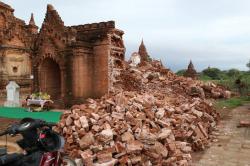 – Bagan - Nearly a dozen temples in Bagan are in urgent need of protection due to recent rains, Burma’s Ministry of Culture said following the collapse of one such structure. Temple No. 1752, which is believed to have been built in the 13th century, buckled on Saturday after being pounded by weeks of unusually heavy rain, the ministry said. Only about 20 percent of the original structure remains. The temple had previously been damaged by an earthquake in 1975, but a 2003 renovation to the tune of 2.5 million kyats (US$2,029) apparently did little to address structural degradation. The Bagan area spans about 42 square kilometers (16 miles) peppered with ancient temples built between the 9th and 13th centuries, when some 55 Buddhist kings ruled the Bagan Dynasty. The central Burma town is one of the country’s biggest tourist draws, charming visitors from across the globe with 360 degree views of ancient Buddhist relics dotting the horizon.
– Bagan - Nearly a dozen temples in Bagan are in urgent need of protection due to recent rains, Burma’s Ministry of Culture said following the collapse of one such structure. Temple No. 1752, which is believed to have been built in the 13th century, buckled on Saturday after being pounded by weeks of unusually heavy rain, the ministry said. Only about 20 percent of the original structure remains. The temple had previously been damaged by an earthquake in 1975, but a 2003 renovation to the tune of 2.5 million kyats (US$2,029) apparently did little to address structural degradation. The Bagan area spans about 42 square kilometers (16 miles) peppered with ancient temples built between the 9th and 13th centuries, when some 55 Buddhist kings ruled the Bagan Dynasty. The central Burma town is one of the country’s biggest tourist draws, charming visitors from across the globe with 360 degree views of ancient Buddhist relics dotting the horizon.
http://www.irrawaddy.org/burma/ancient-temple-in-bagan-collapses-after-heavy-rain.html?
BULGARIE – 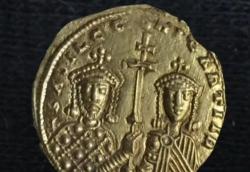
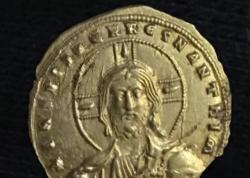 Perperikon - A gold coin of Byzantine Emperor Basil II also known as the Bulgar-slayer (r. 976-1025 AD) has beendiscovered by the team of Bulgarian archaeologist Prof. Nikolay Ovcharov during the on going archaeological excavations of the ancient and medieval rock city of Perperikon (Perperik) in theEastern Rhodope Mountains in Southern Bulgaria. The gold coin is a so called tetarteron (“quarter coin”). It features an image of Byzantine Emperor Basil II together with his brother and successor, Emperor Constantine VIII (r. 1025-1028 AD) on the one side, and an image of Jesus Christ on the other. Emperor Basil II is known, among other things, for his conquest of the First Bulgarian Empire (632/680 – 1018 AD) after several decades of Bulgarian-Byzantine Wars.
Perperikon - A gold coin of Byzantine Emperor Basil II also known as the Bulgar-slayer (r. 976-1025 AD) has beendiscovered by the team of Bulgarian archaeologist Prof. Nikolay Ovcharov during the on going archaeological excavations of the ancient and medieval rock city of Perperikon (Perperik) in theEastern Rhodope Mountains in Southern Bulgaria. The gold coin is a so called tetarteron (“quarter coin”). It features an image of Byzantine Emperor Basil II together with his brother and successor, Emperor Constantine VIII (r. 1025-1028 AD) on the one side, and an image of Jesus Christ on the other. Emperor Basil II is known, among other things, for his conquest of the First Bulgarian Empire (632/680 – 1018 AD) after several decades of Bulgarian-Byzantine Wars.
http://archaeologyinbulgaria.com/2015/08/10/archaeologist-discovers-gold-coin-of-byzantine-emperor-basil-ii-the-bulgar-slayer-in-bulgarias-perperikon/